#romanian easter tradition
Explore tagged Tumblr posts
Text




Art starts with nature
#romanisme#romania#easter#easter eggs#romanian traditions#slavic traditions#orthodox easter#egg decorating
113 notes
·
View notes
Text
Happy Easter everyone look at the eggs I painted


12 notes
·
View notes
Text
Happy Easter!
This year, we're going East, with this Byzantine potpourri. It starts with the traditional Greek Easter song - Χριστὸς ἀνέστη/Christ is risen. Which is also the way people would greet each other, at least for the three days of the feast (or until Ascension Day, for the more invested minority). The customary answer to this is always 'Αληθώς Ανέστη'/Truly, He is risen, all over the Greek-Orthodox world.
The second song is the Romanian Carol for Palm Sunday, I have already posted last year and the third is a modern rewriting of old Byzantine hymns.
youtube
In tearing haste, as I bravely go on with the preparation of the customary gigot d'agneau/leg of lamb - more on this, probably later, for it is taking no less than four hours -, I wish you a Happy Easter, filled with Light, Love and the Joy He so generously shared with all of us.
57 notes
·
View notes
Text
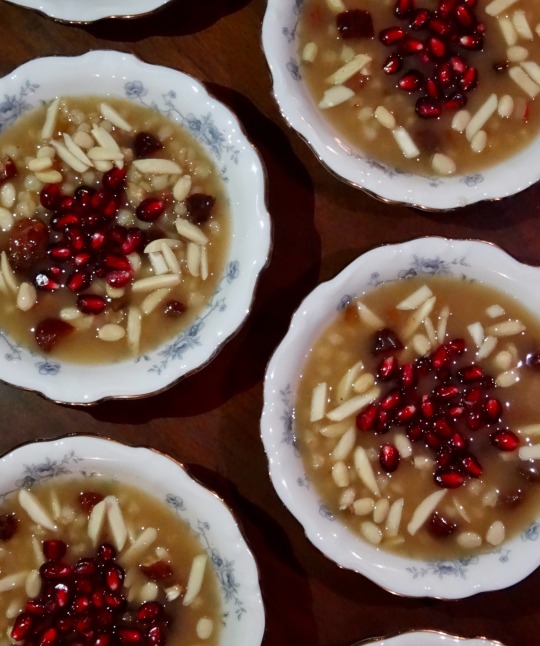

[ID: First image shows four small porcelain bowls of a pudding topped with slivered almonds and pomegranates seeds, seen from above. Second image is an extreme close-up showing the blue floral pattern on the china, slivered almonds, golden raisins, and pomegranate seeds on top of part of the pudding. End ID]
անուշապուր / Anush apur (Armenian wheat dessert)
Anush apur is a sweet boiled wheat pudding, enriched with nuts and dried fruits, that is eaten by Armenians to celebrate special occasions. One legend associates the dish with Noah's Ark: standing on Mt. Ararat (Արարատ լեռը) and seeing the rainbow of God's covenant with humanity, Noah wished to celebrate, and called for a stew to be prepared; because the Ark's stores were diminishing, the stew had to be made with small amounts of many different ingredients.
The consumption of boiled grains is of ancient origin throughout the Levant and elsewhere in West Asia, and so variations of this dish are widespread. The Armenian term is from "անուշ" ("anush") "sweet" + "ապուր" ("apur") "soup," but closely related dishes (or, arguably, versions of the same dish) have many different, overlapping names.
In Arabic, an enriched wheat pudding may be known as "سْنَينِيّة" ("snaynīyya"), presumably from "سِنّ" "sinn" "tooth" and related to the tradition of serving it on the occasion of an infant's teething; "قَمْح مَسْلُوق" ("qamḥ masluq"), "boiled wheat"; or "سَلِيقَة" ("salīqa") or "سَلِيقَة القَمْح" ("salīqa al-qamḥ"), "stew" or "wheat stew," from "سَلَقَ" "salaqa" "to boil." Though these dishes are often related to celebrations and happy occasions, in some places they retain an ancient association with death and funerary rites: qamh masluq is often served at funerals in the Christian town of بَيْت جَالَا ("bayt jālā," Beit Jala, near Bethlehem).
A Lebanese iteration, often made with milk rather than water, is known as "قَمْحِيَّة" ("qamḥīyya," from "qamḥ" "wheat" + "ـِيَّة" "iyya," noun suffix).
A similar dish is known as "بُرْبَارَة" ("burbāra") by Palestinian and Jordanian Christians when eaten to celebrate the feast of Saint Barbara, which falls on the 4th of December (compare Greek "βαρβάρα" "varvára"). It may be garnished with sugar-coated chickpeas and small, brightly colored fennel candies in addition to the expected dried fruits and nuts.
In Turkish it is "aşure," from the Arabic "عَاشُوْرَاء" ("'āshūrā"), itself from "عَاشِر" ("'āshir") "tenth"—because it is often served on the tenth day of the month of ٱلْمُحَرَّم ("muḥarram"), to commemorate Gabriel's teaching Adam and Eve how to farm wheat; Noah's disembarkment from the Ark; Moses' parting of the Red Sea; and the killing of the prophet الْحُسَيْن بْنِ عَلِي (Husayn ibn 'Ali), all of which took place on this day in the Islamic calendar. Here it also includes various types of beans and chickpeas. There is also "diş buğdayı," "tooth wheat" (compare "snayniyya").
These dishes, as well as slight variations in add-ins, have varying consistencies. At one extreme, koliva (Greek: "κόλλυβα"; Serbian: "Кољиво"; Bulgarian: "Кутя"; Romanian: "colivă"; Georgian: "კოლიო") is made from wheat that has been boiled and then strained to remove the boiling water; at the other, Armenian anush apur is usually made thin, and cools to a jelly-like consistency.
Anush apur is eaten to celebrate occasions including New Year's Eve, Easter, and Christmas. In Palestine, Christmas is celebrated by members of the Armenian Apostolic church from the evening of December 24th to the day of December 25th by the old Julian calendar (January 6th–7th, according to the new Gregorian calendar); Armenian Catholics celebrate on December 24th and 25th by the Gregorian calendar. Families will make large batches of anush apur and exchange bowls with their neighbors and friends.
The history of Armenians in Palestine is deeply interwoven with the history of Palestinian Christianity. Armenian Christian pilgrimages to holy sites in Palestine date back to the 4th century A.D., and permanent Armenian monastic communities have existed in Jerusalem since the 6th century. This enduring presence, bolstered by subsequent waves of immigration which have increased and changed the character of the Armenian population in Palestine in the intervening centuries, has produced a rich history of mutual influence between Armenian and Palestinian food cultures.
In the centuries following the establishment of the monasteries, communities of Armenian laypeople arose and grew, centered around Jerusalem's Վանք Հայոց Սրբոց Յակոբեանց ("vank hayots surbots yakobeants"; Monastery of St. James) (Arabic: دَيْر مَار يَعْقُوب "dayr mār ya'qūb"). Some of these laypeople were descended from the earlier pilgrims. By the end of the 11th century, what is now called the Armenian Quarter—an area covering about a sixth of the Old City of Jerusalem, to the southwest—had largely attained its present boundaries.
Throughout the 16th and 17th centuries, the Patriarchate in Jerusalem came to have direct administrative authority over Armenian Christians across Palestine, Lebanon, Egypt, and Cyprus, and was an important figure in Christian leadership and management of holy sites in Jerusalem (alongside the Greek Orthodox and Roman Catholic churches). By the middle of the 19th century, a small population of Armenian Catholics had joined the larger Armenian Apostolic community as permanent residents in Jerusalem, living throughout the Muslim Quarter (but mostly in a concentrated enclave in the southwest); in the beginning of the 20th century, there were between 2,000 and 3,000 Armenians of both churches in Palestine, a plurality of whom (1,200) lived in Jerusalem.
The Turkish genocide of Armenians beginning in 1915 caused significant increases in the populations of Armenian enclaves in Palestine. The Armenian population in Jerusalem grew from 1,500 to 5,000 between the years of 1918 and 1922; over the next 3 years, the total number of Armenians in Palestine (according to Patriarchate data) would grow to 15,000. More than 800 children were taken into Armenian orphanages in Jerusalem; students from the destroyed Չարխափան Սուրբ Աստվածածին վանք (Charkhapan Surb Astvatsatsin Monastery) and theological seminary in Armash, Armenia were brought to the Jerusalem Seminary. The population of Armenian Catholics in the Muslim Quarter also increased during the first half of the 20th century as immigrants from Cilicia and elsewhere arrived.
The immediate importance of feeding and housing the refugees despite a new lack of donations from Armenian pilgrims, who had stopped coming during WW1—as well as the fact that the established Armenian-Palestinians were now outnumbered by recent immigrants who largely did not share their reformist views—disrupted efforts on the part of lay communities and some priests to give Armenian laypeople a say in church governance.
The British Mandate, under which Britain assumed political and military control of Palestine from 1923–1948, would further decrease the Armenian lay community's voice in Jerusalem (removing, for example, their say in elections of new church Patriarchs). The British knew that the indigenous population would be easier to control if they were politically and socially divided into their separate religious groups and subjected to the authority of their various religious hierarchies, rather than having direct political representation in government; they also took advantage of the fact that the ecclesiastical orders of several Palestinian Christian sects (including the Armenian Patriarchate of Jerusalem) comprised people from outside of Palestine, who identified with religious hierarchy and the British authorities more than they identified with the Palestinian lay communities.
British policy, as well as alienating Armenians from politics affecting their communities, isolated them from Arab Palestinians. Though the previously extant Armenian community (called "քաղաքացի" "kaghakatsi," "city-dwellers") were thoroughly integrated with the Arab Palestinians in the 1920s, speaking Arabic and Arabic-accented Armenian and eating Palestinian foods, the newer arrivals (called "زُوَّار" / "զուվվար" "zuwwar," "visitors") were unfamiliar with Palestinian cuisine and customs, and spoke only Armenian and/or Turkish. Thus British policies, which differentiated people based on status as "Arab" (Muslim and Christian) versus "Jewish," left new Armenian immigrants, who did not identify as Arab, disconnected from the issues that concerned most Palestinians. They were predominantly interested in preserving Armenian culture, and more concerned with the politics of the Armenian diaspora than with local ones.
Despite these challenges, the Armenian Patriarchate of Jerusalem came to be a vital center of religious and secular culture for the Armenian diaspora during the British Mandate years. In 1929, Patriarch Yeghishe Turian reëstablished the Սուրբ Յակոբեանց Տպարան ("surbots yakobeants taparan"; St. James printing house); the Patriarchate housed important archives relating to the history of the Armenian people; pilgrimages of Armenians from Syria, Lebanon, and Egypt increased and the economy improved, attracting Armenian immigrants in higher numbers; Armenians held secular roles in governance, policing, and business, and founded social, religious, and educational organizations and institutions; Armenians in the Old and New Cities of Jerusalem were able to send financial aid to Armenian victims of a 1933 earthquake in Beirut, and to Armenians expelled in 1939 when Turkey annexed Alexandretta.
The situation would decline rapidly after the 1947 UN partition resolution gave Zionists tacit permission to expel Palestinians from broad swathes of Palestine. Jerusalem, intended by the plan to be a "corpus separatum" under international administration, was in fact subjected to a months-long war that ended with its being divided into western (Israeli) and eastern (Palestinian) sections. The Armenian population of Palestine began to decline; already, 1947 saw 1,500 Armenians resettled in Soviet Armenia. The Armenian populations in Yafa and Haifa would fall yet more significantly.
Still, the Armenian Patriarchate of Jerusalem maintained its role as the center of Armenian life in Palestine; the compound provided food and shelter to thousands of Armenians during the Battle for Jerusalem and the Nakba (which began in 1948). Some Armenians formed a militia to defend the Armenian Quarter against Haganah shelling during the battle.
In the following years, historical British contributions to the shoring up of insular power in the Patriarchate would cause new problems. The Armenian secular community, no longer empowered to oversee the internal workings of the Patriarchate, could do nothing to prevent embezzling, corruption, and even the sale of church-owned land and buildings to settlers.
In 1967, Israeli military forces annexed East Jerusalem, causing another, albeit smaller, surge in Armenian emigration from the city. Daphne Tsimhoni estimates based on various censuses that the Armenian population of Jerusalem, which had reached 5,000-7,000 at its peak in 1945–6, had fallen back to 1,200 by 1978.
Today, as in the 20th century, Armenians in Jerusalem (who made up nearly 90% of the Armenian population of Palestine as of 1972) are known for the insularity of their community, and for their skill at various crafts. Armenian food culture has been kept alive and well-defined by successive waves of immigrants. As of 2017, the Armenian Patriarchate supplied about 120 people a day with Armenian dishes, including Ղափամա / غاباما "ghapama" (pumpkin stuffed with rice and dried fruits), թոփիկ / توبيك "topig" (chickpea-and-potato dough stuffed with an onion, nut, fruit, and herb filling, often eaten during Lent), and Իչ / ايتش "eetch" (bulgur salad with tomatoes and herbs).
Restaurants lining the streets of the Armenian and Christian quarters serve a mixture of Armenian and Palestinian food. Լահմաջո "lahmadjoun" (meat-topped flatbread), and հարիսա / هريس "harisa" (stew with wheat and lamb) are served alongside ֆալաֆել / فلافل ("falafel") and մուսախան / مسخن ("musakhkhan"). One such restaurant, Taboon Wine Bar, was the site of a settler attack on Armenian diners in January 2023.
Up until 2023, despite fluctuations in population, the Armenian community in Jerusalem had been relatively stable when compared to other Armenian communities and to other quarters of the Old City; the Armenian Quarter had not been subjected to the development projects to which other quarters had been subjected. However, a deal which the Armenian Patriarchate had secretly and unilaterally made with Israel real estate developer Danny Rotham in 2021 to lease land and buildings (including family homes) in the Quarter led Jordan and Palestine to suspend their recognition of the Patriarch in May of 2023.
On 26th October, the Patriarchate announced that it was cancelling the leasing deal. Later the same day, Israeli bulldozers tore up pavement and part of a wall in حديقة البقر ("ḥadīqa al-baqar"; Cows' Garden; Armenian: "Կովերի այգու"), the planned site of a new luxury hotel. On 5th November, Rothman and other representatives of Xana Gardens arrived with 15 settlers—some of them with guns and attack dogs—and told local Armenians to leave. About 200 Armenian Palestinians arrived and forced the settlers to stand down.
On 12th and 13th November, the developer again arrived with bulldozers and attempted to continue demolition. In response, Armenian Palestinians have executed constant sit-ins, faced off against bulldozers, and set up barricades to prevent further destruction. The Israeli occupation police backed settlers on another incursion on 15th November, ordering Armenian residents to vacate the land and arresting three.
On December 28th, a group of Armenian bishops, priests, deacons, and seminary students (including Bishop Koryoun Baghdasaryan, the director of the Patriarchate's real estate department) were attacked by a group of more than 30 people armed with sticks and tear gas. The Patriarchate attributed this attack to Israeli real estate interests trying to intimidate the Patriarchate into abandoning their attempt to reverse the lease through the court system. Meanwhile, anti-Armenian hate crimes (including spitting on priests) had noticeably increased for the year of 2023.
These events in Palestine come immediately after the ethnic cleansing of Լեռնային Ղարաբաղ ("Lernayin Gharabagh"; Nagorno-Karabakh); Israel supplied exploding drones, long-range missiles, and rocket launchers to help Azerbaijan force nearly 120,000 Armenians out of the historically Armenian territory in September of 2023 (Azerbaijan receives about 70% of its weapons from Israel, and supplies about 40% of Israel's oil).
Support Palestinian resistance by donating to Palestine Action’s bail fund; buying an e-sim for distribution in Gaza; or donating to help a family leave Gaza.
Ingredients
180g (1 cup) pearled wheat (قمح مقشور / խոշոր ձաւար), soaked overnight
3 cups water
180-360g (a scant cup - 1 3/4 cup) sugar, or to taste
Honey or agave nectar (optional)
1 cup total diced dried apricots, prunes, golden raisins, dried figs
1 cup total chopped walnuts, almonds, pistachios
1 tsp rosewater (optional)
Ceylon cinnamon (դարչին) or cassia cinnamon (կասիա)
Aniseed (անիսոն) (optional)
Large pinch of salt
Pomegranate seeds, to top (optional)
A Palestinian version of this dish may add pine nuts and ground fennel.
Pearled wheat is whole wheat berry that has gone through a "pearling" process to remove the bran. It can be found sold as "pearled wheat" or "haleem wheat" in a halal grocery store, or a store specializing in South Asian produce.
Amounts of sugar called for in Armenian recipes range from none (honey is stirred into the dish after cooking) to twice the amount of wheat by weight. If you want to add less sugar than is called for here, cook down to a thicker consistency than called for (as the sugar will not be able to thicken the pudding as much).
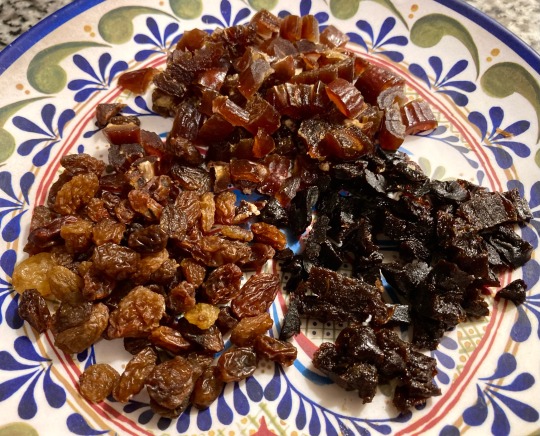
Instructions
1. Submerge wheat in water and scrub between your hands to clean and remove excess starch. Drain and cover by a couple inches with hot water. Cover and leave overnight.
2. Drain wheat and add to a large pot. Add water to cover and simmer for about 30 minutes until softened, stirring and adding more hot water as necessary.
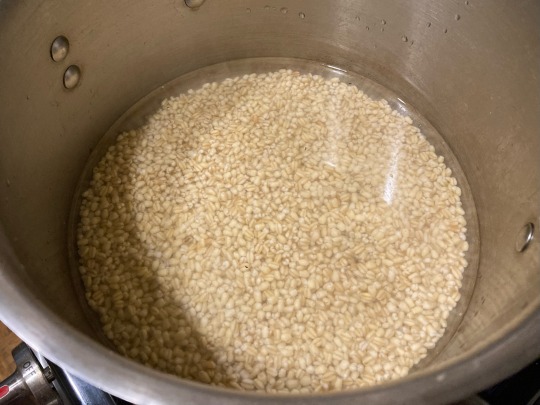
Wheat before cooking

Wheat after cooking
3. Add dried fruit, sugar, salt, and spices and simmer for another 30 minutes, stirring occasionally, until wheat is very tender. Add water as necessary; the pudding should be relatively thin, but still able to coat the back of a spoon.
4. Remove from heat and stir in rosewater and honey. Ladle pudding into individual serving bowls and let cool in the refrigerator. Serve cold decorated with nuts and pomegranate seeds.
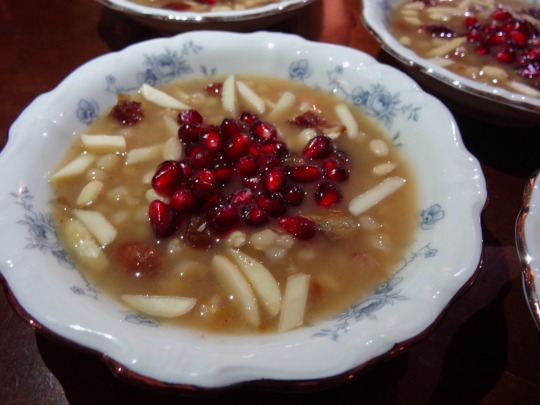
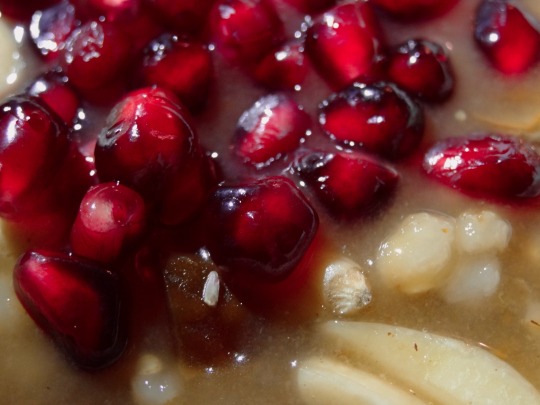
#the last link is a different / new fundraiser#Armenian#Palestinian#fusion#wheat berries#pearled wheats#pomegranate#prunes#dried apricot#dates#long post /
379 notes
·
View notes
Note
um if this doesn't make you uncomfortable
i saw your hc lucifer as orthodox christian and i have an interest in orthodox so can i request some hcs of lucifer as an orthodox christian (like his daily activities as orthodox christian, etc.)
again, if you are feeling uncomfortable, feel free to ignore this, i know many dont feel comfortable with topic of religion
(if you want age confirmation, im an legal adult)
I'm not uncomfortable with talking about my religion, but there's this itty bitty problem that comes up when you discuss orthodox christian traditions. Every countries orthodox traditions are different because, unlike catholic christianity with the pope, there's no authorithy over the whole religion. (There's patriarchs, but they're authorothy over their respective region, not the whole of orthodoxy. It's complicated and I do not have the full understanding on how the orthodox hierarchy works either.)
That's a long way of saying that I'll be writing Lucifer as specificly a romanian orthodox christian because that's the one I'm familiar with.
Lucifer being orthodox on main
There's a day every year when Lucifer will wash the feet of all his nobles. Since he's at the top of the food chain in his country (and in general), he's the one that has to wash the sins away from all his nobles. He used to do it to the patience as well, but they're too many since the war began.
Paradise Lost is the only country that celebrates Easter, but it's during the correct date and not the catholic date.
Easter Eve night is spent at the church where Lucifer sings a specific prayer before leading the atendees around the church three times. Every atendent has to hold a chicken or rooster as they circle the church and at the end they sacrifice the birds to the lord.
Not an orthodox thing exactly, but Lucifer loves decorating eggs with beads, kind of like this

During Easter everyone in Paradise Lost has to smash an egg with everyone else. (I have no idea how to explain it, just have a video. That's basicly it)
youtube
After Easter he greats all his nobles with "Hristos a înviat" ("Christ has been revived" kinda, I'm not a professional translator) and his nobles have to answer "Adevărat a înviat" ("True, he's been revived."). This goes on for a month
Moving on from Christmas, whenever a patient dies, Lucifer rushes to their room and lights candle.
No noble in Paradise Lost ever dies (thank you, Gamigin) but Lucifer has a whole ass plan prepared for the possibility of them dying. I talking casket measurements, a list of their favorite foods so he may give it out as pomană, the prayer he'll honor them with, everything
Whenever something bizarre or unorthodox (haha) happens, Lucifer will let out a quiet "Doamne fereşte" ("God forbid") and look at an icon (he has those in every room).
He was given a cross necklace when he was younger by God and he never takes it off. Will hiss at anyone that even tries to touch it.
Lucifer only wears red underwear. It's to prevent people from putting envy curses on him. If he's praising someone a lot, at some point he'll do the "pu pu pu să nu te deochi" ("[spitting noise] may I not curse you")
He sometimes calls his brothers by their hebrew names, that's Gavril, Mihail and Rafail. Kind of preferes calling them by those names, but he can go with the latin version as well.
I'mma be honest, these were the hardest headcanons to write for. There's so many romanian words that have no direct translation and all of them are related to religion in some way 😭😭😭 I didn't even bring up the strigoi or jumping over fire. I've been told before that I kind of need to tone down the use of Romanian on my blog since not everyone is from here, so I tried my best with translations.
#whb#what in hell is bad#whb lucifer#whb paradise lost#I hope it makes sense#I really want to talk about my traditions and how I hc other characters from media to have them#but it's difficult when you have to explain what every word means
55 notes
·
View notes
Text
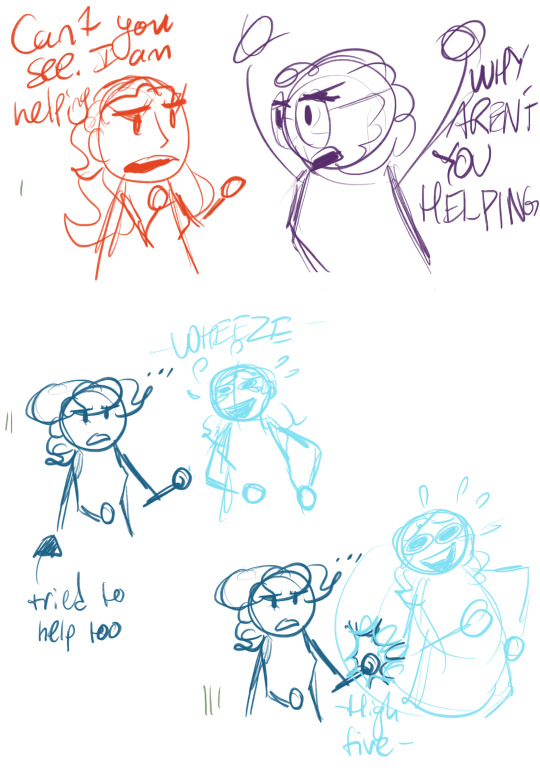
This was a genuine moment today at Orthodox Romanian Easter Lunch tradition with my mom and gran (featuring a family friend who was a former housemate)
#Chris rambles#my creations#I’m dead serious I was just watching the situation with a ‘what the hell’ moment frozen in time trying to help hand over the sour cream#and with just my hands held out open and not knowing what to do#and this girl. G-d love her. she low-fives me#a normal situation. as you will.#deeply hilarious now that I think of it
6 notes
·
View notes
Text


happy easter guys
#romanisme#romania#easter#eastern europe#balkans#romanian traditions#slavic traditions#orthodox easter#orthodox church
29 notes
·
View notes
Note
Hey Cris!
4, 7, 9 (the star-crossed lovers au :3), 15, 23 (Who painted the sky?)
hi Anna! thank you for the ask ♡
For the star-crossed lovers au:
4. What is the hardest to write in it?
hmmm the smut the timeline. it might sound weird, but the timeline, because i set the fic in the 1950s in a romanian village, and that period of time was a rather difficult one for my country. by the time Nothing Sweeter Than You happens, all the land would have been taken from the peasants and most villages would have been emptied. only a few survived, and barely. so i guess getting the political background right is the hardest about that fic
7. Which chapter was the most fun to write/which chapter has been the most fun so far to write?
the secret third one i haven't posted yet :3
9. How did you get inspired to write this?
it was easter 2022. i had just gone through a terrific experience and i couldn’t sleep properly. we visited relatives for easter and they had the tv open to listen to folk music. at some point, a lady appeared on the tv and started talking about easter traditions and the one where the boy gives the girl a red egg to confess his love came up and it fascinated me so much, because it was adorable? and my brain went like, oh armin would definitely do that. so i took my phone out and started writing A Perfect Love was completely entirely wrotten by midnight that day. but i didn’t post it back then, i didn’t lile it that much at the time. the idea of the star,crossed lovers stayed with me though, and i brainrotted over it for months. then i wrote Nothing Sweeter than You and decided to actually post it, since it was Armin’s birthday anyway. and people like it! and then i posted the first one on Easter this year. and now, more than a year after the idea first came to me, i'm still brainrotting over it lmao
(i'm genuinely so happy that you like that story Anna, i'm really so honoured that you read it, thank you so much for all your support ♡)
For wpts:
15. Favorite character to write for?
hitch actually. and annie
23. How many chapters do you think it will be?
i originally planned 21 but i (spoiler) i'm almost done with 18 and it looks like the story is nowhere near done. so maybe 30-35
2 notes
·
View notes
Text




Apple&walnuts pie
Romanian traditional Easter cheesecake with a twist- or ‘pască’ without dough and with a poppyseed filling
A cheddar, jalapenos&dried tomatoes sourdough loaf
Some triple choc chips cookies that went on a hike
I call this post ’the last baked goods before the fall of democracy’ 🫠
0 notes
Text

The Resurrection of Christ, according to the Apostle Paul, is the foundation of our faith. Pentecost is the culmination of Easter. Holiness is the fruit of Pentecost. There is a special connection between the holy departed, between the departed and Easter. That is why there is an obligatory day of remembrance in Orthodoxy - Parental Saturday on the eve of Pentecost, 9 days before All Saints. Another universal commemoration is held 9 days before Lent. It is possible that our tradition of special prayer for the departed on the 9th day after death originates from the calendar arrangement of these universal days. In the Russian Church, there is also a tradition of special commemoration of the departed on the 9th day after Easter. The name of this day is Radonitsa. There are different versions of the etymology, but literally this archaic Slavic word is consonant with the Day of Joy. It is on this day, according to the charter, that the service of requiems is permitted. The departed are always remembered in the prayers of the liturgy. The petition for all our departed fathers and brothers is read daily at the litany of fervent supplication, including on Easter days. But separate commemoration is not provided for until Radonitsa. Historians and theologians explain the origin of this holiday in different ways. In one form or another, it also exists in the Serbian, Georgian, Romanian and Polish churches of the Universal Orthodoxy. "Care for the Dead" is the title of his treatise on commemoration by the father of the Ancient Church, Saint Augustine. It is very important to remember that the prayer for the departed on Radonitsa is not a folk custom, not some tradition originating from paganism, but a genuine evangelical expression of care for the dead, which the Holy Fathers taught Orthodox Christians. Christ is Risen!
1 note
·
View note
Text

31.03.2024 Although the traditional Polish food for Easter is very different from the Romanian one, I am 100% subscribed to it.
#91of366
#Homeisacupoftea#mymagicalmorning#coffeestoriesandflowers#Thestilllifecollective#myhousebeautiful#flatlayfriday#flatlaylover#fromabove#flatlaybreakfast#flatlaysquad#naughtyteas#coffeeandhands#cupsinframes#onthetable#dineandwine#lifeandthyme#coolflatlays#healthybreakfast#eatclean#nomnom#onequietcup#adoremycupoftea#joinmeforcoffeedear#kinfolktable#stylemycoffee
1 note
·
View note
Text

Cozonac (Romanian: [kozoˈnak]) or Kozunak (Bulgarian: козунак [kozuˈnak]) is a sweet yeast dough that can be used to make different traditional holiday breads and cakes. Often mixed with raisins, it can be baked as a loaf or rolled out with fillings like poppy seed or walnuts. It is common throughout Southeastern Europe, Romania, Bulgaria and Serbia, North Macedonia, Greece, etc. Rich in eggs, milk and butter, it is usually prepared for Easter in Romania, Serbia, Bulgaria, and in Romania and Moldova it is also traditional for Good Friday. The name comes from the Bulgarian word for hair-коса/kosa, or Greek: κοσωνάκι, romanized: kosōnáki, a diminutive form of κοσώνα, kosṓna.
0 notes
Note
does their family/friends have any traditions they take part in? are they good at explaining things to others?
THE REAL IMPORTANT CHARACTER DEVELOPMENT QUESTIONS PART 2 | Accepting


He and his parents follow the traditions most Romanian Orthodox followers do, celebrating Easter and Christmas on their appropriate dates together. But his family does have a specific tradition on Christmas Eve and Christmas Day, they will watch Home Alone and then the next day Home Alone 2. His friends don't exactly have traditions necessarily, but they have a method to how they go out and enjoy their free time. Though one could say when a birthday is coming up they will make sure that night that the person gets absolutely wasted, not paying for a single drop of alcohol or food.
Andrei likes to think he is good at explaining things, sometimes he is and sometimes he isn't. It honestly depends on the topic. If it's something he knows by heart, like soccer/football or working out then he is one of the best at explaining things to someone. If it's about expressing feelings, then one might want to try and go somewhere else for that. However, he does try to do his best at explaining no matter what when someone comes to him with something and asking for help. He will never turn someone away and does try to the best of his ability, he just knows sometimes it isn't the best and he will warn them about that before continuing on so they can decide of they want better advice or not.
#mcmorare#( this is gonna be soccer verse because i said so )#🔪 — мore тнan jυѕт a ѕoldιer ╲ ( нeadcanon )#🔪 — мιa ѕan мιa ╲ ( verѕe 12 )
1 note
·
View note
Photo
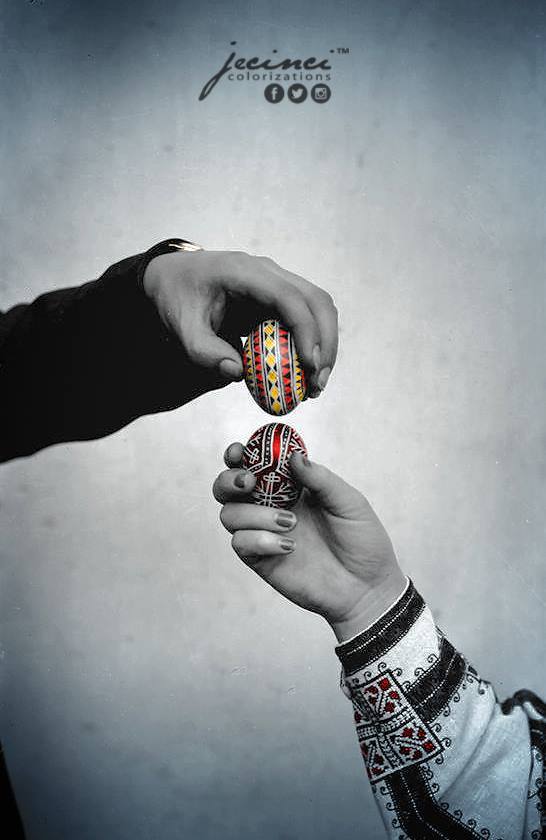
Happy Easter
Easter in Romania is one of the most important and beautiful Christian Holidays, celebrating the Resurrection of Jesus Christ.
The main tradition is decorating/dying the eggs red or in different colours on Good Friday, then on Easter people gather to crack the dyed eggs while saying ”Jesus is Risen” to which the response is “ He has truly risen/ Indeed He is.”
source: Istorie in culori
30 notes
·
View notes
Text
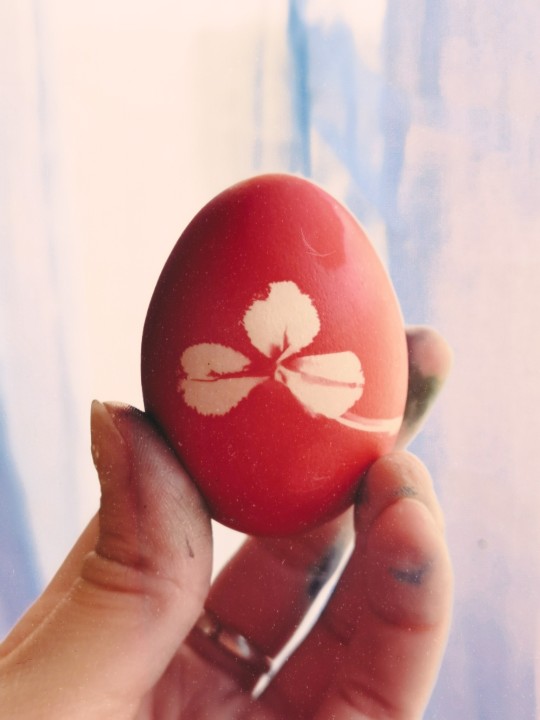


Easter minimalism
#romanisme#romania#eastern europe#balkans#easter#orthodox easter#orthodox traditions#easter egg#romanian traditions#romanian folklore
192 notes
·
View notes
Text
BONUS CHAPTER!!!!!!!!!!!!!
Dimitrescu Books
Chapter 26 <<Link
Easter 2008
Explicit: only suitable for adults
The girls dye Easter eggs with Uncle Karl. What could go wrong?
THIS chapter takes place in 2008, three years after Alcina adopts the girls. Karl, his mother, and "the Romanians" (Alcina's Father and Grandfather) as Karl's mother refers to them, are still alive. Miranda is also mentioned in this chapter, but does not make an appearance. Our Dimi girls are 10, 7, and 5. Karl is 29, Alcina is 33.
Bela, being ten knew better. “Bunic and Mamă’s fancy glasses?” She shook her head.
Bunic? Karl knew the word sounded familiar. Maybe it meant bunny? After three years of hearing the girls call their grandfather bunic, one would think he could remember that it was Romanian for grandfather, but no.
“Uh no, kiddo, close. Easter Bunny . Bunny . Not Bunic . Your mom and the Easter Bunny want you to make some eggs.”

Artist Credit: Dastelia Digital or traditional art #dastelia vk.com/club211086418
Check out their amazing work here: https://www.instagram.com/dastelia/
#house dimitrescu#karl heisenberg#bela dimitrescu#cassandra dimitrescu#daniela dimitrescu#re8 au#read on ao3#fanfiction#fan fic#mother miranda#bookstore au#cafe au
23 notes
·
View notes